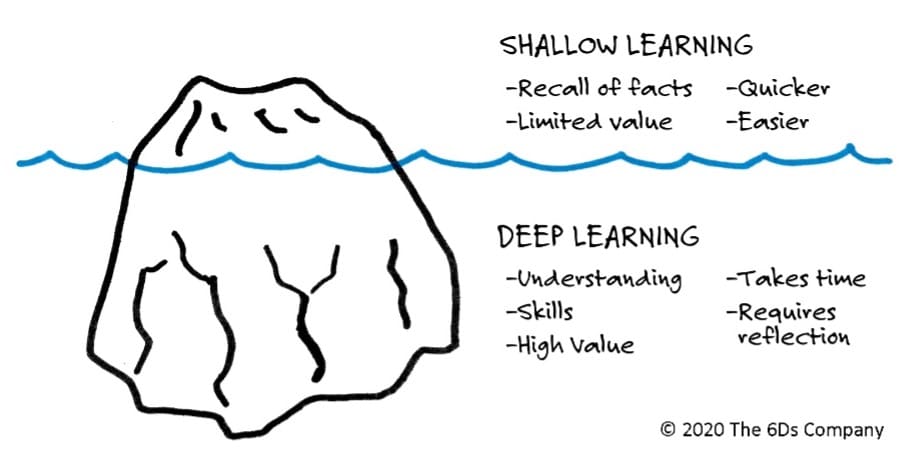In Gary Larson’s famous cartoon, a student asks his teacher if he can be excused because his brain is full. It’s funny as a cartoon, but it is not funny from a corporate training standpoint. Cognitive overload is an all-too-common condition that results from presenting an amount of information that exceeds the capacity of working memory and the encoding process.
It’s tempting to think of cognitive overload as overfilling a glass with water – the excess just spills over the top and is wasted. But, cognitive overload is more complex and may prove costlier than that.
When people are presented with too much content too quickly, it is not only the extra “nice-to-know” information that is lost. This is because learners are unable to adequately process the content, they cannot create rich neural networks and easily retrievable long-term memories.
Information overload leads to confusion and interferes with mastering even basic concepts.
There is a finite limit to how much a person can grasp and process in a given session. This is partly due to limited processing capacity, and partly because of the challenge of paying attention for prolonged periods. Even when the topic and presentation are interesting, cognitive overload may cause attention to wander eventually. And, once the learners stop paying attention, they stop learning.
Why Is Cognitive Overload So Common?
This is partly because we rely on subject-matter experts – people with deep knowledge and passion for their chosen fields. In their eagerness to share their expertise, subject matter experts often forget how hard it was for them initially to master the core concepts and specialized language of the field.
As a consequence, SMEs frequently include far more information than a novice would need. The extra details and theoretical digressions create cognitive overload. It has the opposite of the intended effect, ultimately slowing the acquisition of competence.
There is also the “tyranny of time.” Most L&D departments are under pressure to reduce the amount of time that employees spend on corporate training. So, they often take steps to shorten training time by packing as much content as possible into each program. But this is a “false” economy. As Ruth Clark famously observed: “Content covered is not content learned.” Just because the information was presented doesn’t mean people learned it or will be able to apply it to their jobs.
How to Reduce Cognitive Overload in Training?
Reducing cognitive overload is surely one of the key strategies to improve training & development. Here is how you can do that.
First, we need to rigorously analyze and then prioritize what people need to learn. This will enable them to achieve the organization’s business goals.
Second, we need to follow the advice of Joe Harless: “Never ask a subject matter expert ‘What do people need to know about this subject?’ Only ask, ‘What do people need to be able to do?’” Shifting the focus from content to performance is one great way to prevent information overload.
Third, employ approaches like chunking, microlearning, spacing, interleaving, and reflection that break up the content and space learning out over time. This will lead to improved focus and deeper learning.
Deep Vs. Shallow Learning
Shallow or superficial learning is the ability to recall specific facts or concepts, without necessarily understanding or being able to apply them. Deep learning, on the other hand, entails understanding the underlying principles and how the concepts can be applied to novel situations.
Shallow learning can be achieved quickly in a single pass or through a simple drill (think flashcards). Deep learning requires more mental effort and practice to create the rich mental framework needed for effective problem-solving. Success in most jobs requires deep learning; just knowing the “facts” of management does not make you an effective manager.
Training techniques that help facilitate deep learning – and simultaneously avoid cognitive overload – include:
Chunking
Breaking the subject or skill into smaller, logical segments or subroutines is one of the most popular training and development best practices. Chunking is how experts overcome the limits of working memory. Chunking content for instruction helps improve focus, reduce the potential for overload, and increase recall. As you might expect, novices benefit more from chunked instruction than those who already have considerable knowledge or experience in the subject. Effective chunking makes the relationships among the component parts clear as well as showing how they fit into the larger context.
Spaced Learning
It involves learning a topic in several sessions with intervals in between. Spaced learning is a much more effective strategy than cramming (trying to learn everything in one session). In part, this is because of the “forgetting” that occurs between study sessions, which creates a “desirable” difficulty. When you return to a topic after doing something else for a while, extra mental effort is required to recall where you left off and what you had learned previously. That extra effort results in richer understanding and deeper learning.
Interleaving
Mixing related, but distinct material during the study is known as interleaving. A surprising finding of recent learning research is that it is more effective to interleave subjects, rather than to concentrate on just one at a time. Although it seemed counterintuitive to art teachers, students learned to recognize paintings better when they studied more than one artist at a time – interleaving different works by different painters – than when each artist’s paintings were studied separately; probably, because it forced them to pay more attention to the differences.
Taken together, these observations suggest that we can improve the effectiveness of corporate training programs by chunking the content into smaller units, revisiting topics at intervals, and interleaving topics.
Microlearning
It is a way to accomplish these goals. Microlearning involves keeping learning experiences relatively short but without sacrificing good learning practices like active engagement and practice. Good microlearning depends on appropriate chunking and is well-suited to spaced learning and interleaving.
Because each learning experience is relatively short, it is easier for learners to maintain focus and attention. It is also easier for them to return to topics they found challenging. As with chunking, the microlearning topics need to be part of an overall framework and the relationships among topics must be clear. These topics also need to include an appropriate amount of repetition and cross-references to reinforce prior learning. Otherwise, they will be perceived as separate, isolated bits and won’t build toward a deep understanding of the subject.
Also Read: Discover the Power of Microlearning
Bottom Line
Corporate training is not about stuffing people full of facts the way one would stuff a Christmas goose. The goal of corporate training is to improve performance. Improved performance requires deep learning and practice. Chunking content, limiting the cognitive load, and spacing out shorter microlearning sessions can improve training effectiveness across a wide range of topics and skills.
Author: Dr. Roy Pollock, Chief Learning Officer of the 6Ds Company and the co-author of The Six Disciplines of Breakthrough Learning: How to Turn Training and Development into Business Results.

Achieve Effective & Affordable Video Training
– uQualio is an award-winning, easy-to-use, all-in-one NextGen LMS software for any types of online video training.











